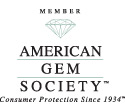Recertification Blues – Passing the American Gem Society Annual Exam
December 14th, 2008 by James L. Sweaney, CGA, FGA. GGEvery year in the fall, I receive the materials to prepare for my annual recertification exam. Sigh! All titleholders in the American Gem Society are required to pass an examination of skills and gemological knowledge annually. The AGS hosts yearly conclaves around the USA, in which seminars and classes present the latest information on gemology and the retail jewelry business. The subject matter of the recertification exam reflects much of what is presented at Conclave.
This year, a large portion of the exam dealt with the latest techniques of diamond grading the AGS way. Our AGS Laboratory and research team are at the forefront of diamond grading, along with sister organization the Gemological Institute of America (GIA). The innovative AGS Diamond Grading System is probably the most advanced and stringent of all, particularly regarding cut grading.
The AGS system has always placed a high priority on actually grading the cut of a diamond rather than just describing it. The idea of a cut grade was to rate the brilliance of the diamond, based on light performance. The AGS system in its original form, like the GIA system, applied only to round diamonds, but even at that, it was the only cut grade available to consumers.
The AGS Cut Grading System uses numbers 0 to 10 to rate the cut of the diamond – the lower the number, the higher the grade. 000 is the ultimate cut grade, meaning the proportions, symmetry, and polish are perfect.
Our AGS cut grades have always been stringent, requiring both proper proportions for maximum light performance and meticulous cutting craftsmanship to attain a high cut grade. When I worked at the GIA Lab in Santa Monica as a diamond grading supervisor in the early 80’s, we used to joke about how tough on the diamond the AGS grading was, that it was so picky that no stone could get a 0 grade. Today’s cutters are so skilled that AGS 000 cut grades are becoming the norm for high quality diamonds.
One of the most revolutionary changes the AGS Diamond Grading Lab has made to the AGS grading system is to rely on performance-based data to grade the brilliance of a diamond, rather than on static rules based on mathematical formulae. When I first became a gemologist in 1976, the ultimate diamond cut, known as the Ideal Cut, was a design based on a formula developed in 1919 by an engineer and diamond cutter named Marcel Tolkowsky. His analysis predicted light performance based on optical geometry and the physical properties of diamond. The limits of this approach are that the formula was only valid for a round diamond and it really only considered one model of performance.
Today’s AGS cut grades go much further. Using computers and the AGS Performance Grading Software, our AGS labs and suppliers can evaluate each diamond individually based on sophisticated ray tracing and computer modeling. The actual light performance is measured and quantified objectively. While the traditional Ideal Cut diamond has been proven to be a superb performer, other cutting designs are proving to be dazzling as well.
The good news gets even better– as the research continues, the AGS approach will allow us to accurately grade the cut of other shapes of diamond, not just the traditional round brilliant. We already have a cut grade for the Princess cut, and more standards are on the way.
There is no bad news— the AGS cut grade system now gives the cutters better ways to cut diamonds, we retailers have a reliable way to buy the brightest diamonds possible based on objective standards, and the consumer wins with the most beautiful diamond available.
By the way, I passed my CGA recertification exam with a score of 96%. Last year was 98%; I’ve been shooting for 100%. Dang!
Tags: AGS, American Gem Society, Cut Grade, Diamond Grading, Gemology Certification







